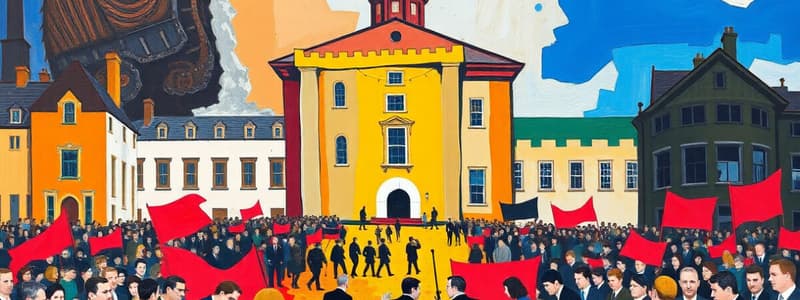Podcast
Questions and Answers
What was the main reason for the failure of the Sunningdale Agreement?
What was the main reason for the failure of the Sunningdale Agreement?
- The lack of support from the British government.
- The failure to reach a compromise on the role of the Irish government in Northern Ireland.
- The lack of consensus on the principles of power sharing.
- The opposition from both Unionist and Protestant groups, and Paramilitary campaigns. (correct)
What was the primary reason for the introduction of direct rule in Northern Ireland?
What was the primary reason for the introduction of direct rule in Northern Ireland?
- The resignation of Prime Minister Wilson.
- The rising pressure from the international community.
- The escalation of the conflict and increasing violence. (correct)
- The collapse of the Northern Ireland government due to the strike.
What was the primary cause of worker strike mentioned in the text?
What was the primary cause of worker strike mentioned in the text?
- The accusations of "sponging" made by Prime Minister Wilson. (correct)
- The introduction of direct rule by the British government.
- The refusal of the Unionist parliament to implement power-sharing.
- The failure of the Sunningdale Agreement.
What was the Downing Street Declaration 1993, as mentioned in the text, similar to?
What was the Downing Street Declaration 1993, as mentioned in the text, similar to?
What was the significance of the failure of the Sunningdale Agreement?
What was the significance of the failure of the Sunningdale Agreement?
What was a key factor that contributed to the failure of the Sunningdale Agreement?
What was a key factor that contributed to the failure of the Sunningdale Agreement?
Who was the Northern Ireland secretary that replaced the conservative government after the general election?
Who was the Northern Ireland secretary that replaced the conservative government after the general election?
What legal action was taken against the Sunningdale Agreement?
What legal action was taken against the Sunningdale Agreement?
What was stated in the articles two and three of De Valera's 1937 Constitution?
What was stated in the articles two and three of De Valera's 1937 Constitution?
What major event did the Ulster Workers Council strike initiate?
What major event did the Ulster Workers Council strike initiate?
Which political party was in control of the UK government during the general election that followed the Sunningdale Agreement?
Which political party was in control of the UK government during the general election that followed the Sunningdale Agreement?
What was one of the noticeable effects of the Ulster Workers Council strike?
What was one of the noticeable effects of the Ulster Workers Council strike?
Which individual believed that the hesitance of Rees was influenced by unionist majority opposition?
Which individual believed that the hesitance of Rees was influenced by unionist majority opposition?
What was the immediate outcome of Bloody Sunday?
What was the immediate outcome of Bloody Sunday?
Which group primarily supported the White Paper proposed by William Whitelaw?
Which group primarily supported the White Paper proposed by William Whitelaw?
What was one of the major opposition points for Unionists regarding the power-sharing agreement?
What was one of the major opposition points for Unionists regarding the power-sharing agreement?
What was the effect of the White Paper on the political landscape in Northern Ireland?
What was the effect of the White Paper on the political landscape in Northern Ireland?
What was a notable feature of the results from the new assembly elections on June 29, 1973?
What was a notable feature of the results from the new assembly elections on June 29, 1973?
Who were the primary opponents of the White Paper within the Republican community?
Who were the primary opponents of the White Paper within the Republican community?
How did the divisions within the Ulster Unionist Party manifest regarding power-sharing proposals?
How did the divisions within the Ulster Unionist Party manifest regarding power-sharing proposals?
What phrase best describes the British troops' orders during the incident leading to Bloody Sunday?
What phrase best describes the British troops' orders during the incident leading to Bloody Sunday?
What was the primary reason for the British government taking direct control of Northern Ireland in 1972?
What was the primary reason for the British government taking direct control of Northern Ireland in 1972?
What event marked a turning point in the British government's decision to implement direct rule in Northern Ireland?
What event marked a turning point in the British government's decision to implement direct rule in Northern Ireland?
How did the British army's involvement in Northern Ireland initially affect the situation?
How did the British army's involvement in Northern Ireland initially affect the situation?
What was a consequence of the internment policy implemented by the Stormont government?
What was a consequence of the internment policy implemented by the Stormont government?
How did the failure of the Unionist government in Northern Ireland affect Westminster's position on direct rule?
How did the failure of the Unionist government in Northern Ireland affect Westminster's position on direct rule?
What role did the 'peace walls' play in the escalating violence in Northern Ireland?
What role did the 'peace walls' play in the escalating violence in Northern Ireland?
What does the content suggest about the position of the British government in the lead up to direct rule?
What does the content suggest about the position of the British government in the lead up to direct rule?
Which of these factors is NOT a primary cause of the downfall of Stormont?
Which of these factors is NOT a primary cause of the downfall of Stormont?
Flashcards
Sunningdale Agreement
Sunningdale Agreement
A failed attempt at power-sharing in Northern Ireland aimed at peace.
Direct Rule
Direct Rule
British government control imposed on Northern Ireland due to escalating conflicts.
Good Friday Agreement
Good Friday Agreement
A landmark agreement in 1998 aimed at achieving peace in Northern Ireland.
Downing Street Declaration
Downing Street Declaration
Signup and view all the flashcards
Interment
Interment
Signup and view all the flashcards
Bloody Sunday
Bloody Sunday
Signup and view all the flashcards
William Whitelaw
William Whitelaw
Signup and view all the flashcards
White Paper
White Paper
Signup and view all the flashcards
Pledged Unionists
Pledged Unionists
Signup and view all the flashcards
Unpledged Unionists
Unpledged Unionists
Signup and view all the flashcards
Council of Ireland
Council of Ireland
Signup and view all the flashcards
Unionist Opposition
Unionist Opposition
Signup and view all the flashcards
PDEVLIN Quote
PDEVLIN Quote
Signup and view all the flashcards
Kevin Boland's Supreme Court Case
Kevin Boland's Supreme Court Case
Signup and view all the flashcards
Articles Two and Three
Articles Two and Three
Signup and view all the flashcards
UWC Strike
UWC Strike
Signup and view all the flashcards
Northern Ireland Secretary
Northern Ireland Secretary
Signup and view all the flashcards
Collapse of Stormont
Collapse of Stormont
Signup and view all the flashcards
Battle of the Bogside
Battle of the Bogside
Signup and view all the flashcards
Stormont
Stormont
Signup and view all the flashcards
Irish Republican Army (IRA)
Irish Republican Army (IRA)
Signup and view all the flashcards
Barbed Wire Barricades
Barbed Wire Barricades
Signup and view all the flashcards
Study Notes
Downfall of Stormont and Sunningdale Agreement
- British government took direct control of Northern Ireland on March 23, 1972, ending 52 years of Unionist rule in Stormont.
- Direct rule was necessitated by escalating violence between Unionists and Nationalists, culminating in a two-day riot during the Battle of the Bogside (August 12, 1969).
- The Royal Ulster Constabulary (RUC) proved incapable of controlling the mobs and arson attacks, prompting the deployment of the British Army on August 14, 1969.
- Barbed wire barricades, later replaced with concrete walls, were erected to separate Protestant and Catholic areas.
- The Irish Republican Army (IRA) gained strength, organizing attacks from behind the barricades and achieving a high level of power by 1970.
- British Army control was short-lived, worsening the situation and making direct rule unavoidable.
Bloody Sunday
- On January 30, 1972, a march against internment escalated into Bloody Sunday, a day of violence in Derry, Ireland.
- British troops shot and killed 13 civilians during a protest.
- This event further fueled opposition and contributed to the decision to impose direct rule.
Sunningdale Agreement and its Failure
- William Whitelaw was appointed the first secretary of state for Northern Ireland to attempt to negotiate a power-sharing agreement.
- A White Paper was published to facilitate negotiations between Nationalists and Unionists.
- Division within the Ulster Unionist Party (UUP) over proposals hampered progress.
- Opposing factions of the UUP (pledged vs unpledged unionists), particularly Paisley, Craig, and Hess, opposed the agreement.
- The Sunningdale Agreement faced opposition and internal division early on.
- Deep-seated divisions and opposition from Unionists led to its failure.
Reasons for Agreement Failure
- The promise of a Council of Ireland created significant opposition from unionists, who viewed it as a threat to Northern Ireland remaining part of the United Kingdom.
- The Irish government's case against the agreement, emphasizing its position on the Irish Free State, further heightened unionist resistance.
- The withdrawal of skilled negotiator, William Whitelaw, and replacement with a less experienced successor, were critical setbacks hampering progress.
- Political maneuvering, divisions, and mistrust hindered progress toward a power-sharing solution.
- Unionist anger over the agreement led to the Ulster Workers' Council (UWC) strike, impacting essential services.
- General election results further complicated the political landscape in Northern Ireland and contributed to the collapse of the Sunningdale Agreement.
Studying That Suits You
Use AI to generate personalized quizzes and flashcards to suit your learning preferences.



